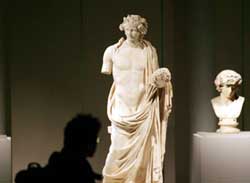
It's where civilization's very first tools from Africa, crafted
nearly 2 million years ago, can be found along with contemporary
art from all around the world. Zhao Caixia, a real estate company
clerk, had a memorable time on Saturday at the Capital Museum in
western Beijing.
"One of the first, lucky visitors to British Museum's 'Treasures
of the World's Cultures' exhibition, I was thrilled to have the
rare chance to listen to the wonderful lectures given by directors
of the two museums," she recalled.
"I may pay a second visit to the Capital Museum for a careful
look at the precious exhibits since, for the time being, I find no
time to travel afar to cities like London, Paris and New York to
satisfy my curiosity for prestigious art museums."
British Museum's touring "Treasures of the World's Cultures"
exhibition opened on March 18 at a 1,400-square-meter hall in the
newly-built Capital Museum. It will run through June 5.
Co-sponsored by Industrial and Commercial Bank of China and the
Hong Kong-based Standard Chartered Bank, the exhibition is "the
first fruit of a cultural exchange programme between the two
museums, which was settled in September 2005 when Wang Qishan,
mayor of Beijing, was visiting London," Guo Xiaoling, director of
the Capital Museum, told China Daily.
And it is the first time that the world's oldest national public
museum is showcasing part of its collections in Beijing.
"We trust that the Chinese public will enjoy the chance to
explore this selection of world cultures. And we hope that it will
mark a further step to be followed by many more in the friendly
collaboration between our two cities and our two countries," said
Neil MacGregor, director of the British Museum, during last
weekend's opening ceremony.
Early in 1999, the British Museum participated for the first
time in a small exhibition in East China's metropolis of
Shanghai.
But the ongoing exhibition in Beijing is the largest and most
comprehensive ever held in China by the British Museum, said
MacGregor.
"Over the past few months, we have put all our heart into the
preparations for this grand exhibition," said Guo.
"Most Chinese have only gained a vague idea of world art through
texts and photo albums. This time, I believe they will have an
intimate encounter with world art with their own eyes."
A wealth of treasures
The British Museum was founded by an act of the Parliament of UK
in 1753, the first national museum in any country.
The aim was "to gather into one building objects from the whole
world, past and present, so that visitors from across the world
could compare the ways in which different societies had organized
themselves and different peoples had addressed the common problems
of humanity," said MacGregor.
After at least 253 years of compiling and research, the
collection today allows the whole world to look at what it has
made, he said.
The "Treasures" exhibition reflects this global reach and
supports the museum's founding principles. It is one example of the
British Museum's extensive programme of loans across the UK and the
world, MacGregor said.
Before its appearance in China, the "Treasures of the World's
Cultures" exhibition had toured Japan and South Korea over the past
three years, both of which turned out to be huge successes, said
Jane Portal, assistant keeper of the British Museum's Department of
Asia.
When exhibited in four Japanese cities, including Tokyo, the
exhibition drew more than 1.3 million visitors in October 2003 and
August 2004; and in South Korea, it attracted an average of 3,400
people to the Seoul Art Center every day, she said.
Priceless exhibits
With 272 priceless articles, including sculptures, paintings,
jewellery, porcelain, and stone artifacts that have been collected
from the world's five continents by the museum since it was founded
in 1753, the grand exhibition covers a vast span of time from 2
million years ago to the present day.
The treasures on show are divided into 13 parts based on their
origins and dates, such as ancient Egypt, Greece and Rome, Europe
in the Middle Ages, and modern art.
It documents the magnificently diverse expressions created by
different groups and individuals.
Among the exhibits are brilliant examples of Egyptian mummy
boards and portraits, exquisite Assyrian reliefs, marble statuary
and coinage from Greece and Rome. There's also a replica of the
famous Sutton Hoo helmet, the Rosetta Stone from Egypt (a slab
dating back to around 200 BC), Islamic Astrolabes, mosque lamps and
hanging scrolls from Asia. Visitors can gaze at plaques from Benin,
a Maori war whistle from New Zealand, drawings by Leonardo and
Raphael, and some prints by Rembrandt and Goya.
It also features the oldest object in the British Museum a stone
chopping tool from Olduvai Gorge, Tanzania, believed to have been
made nearly 2 million years ago and so far the first known
technological invention by human beings, said Jane Portal, who acts
as a key co-coordinator for the Beijing exhibition.
Capital Museum has welcomed the treasures on loan from the
British Museum with newly-purchased showcases, each at least
100,000 yuan (US$12,330), which are hyper-sensitive to changes in
temperature and humidity.
Moreover, about 50 guides, including 40 recruited university
students who have received some training at the Capital Museum,
will serve the visitors; electronic audio guides, either in Chinese
or in English, are also available.
Guo said that to help promote the knowledge of world art, the
Capital Museum has also arranged six free lectures on the topic, to
be delivered by Chinese scholars, during the exhibition.
Students and senior citizens aged 60 and above can buy the
40-yuan (US$5) ticket for the special show at a 50 per cent
discount.
Guo estimated that more than 400,000 people in Beijing are
expected to see 2 million years of history and art with their own
eyes.
(China Daily March 24, 2006)

